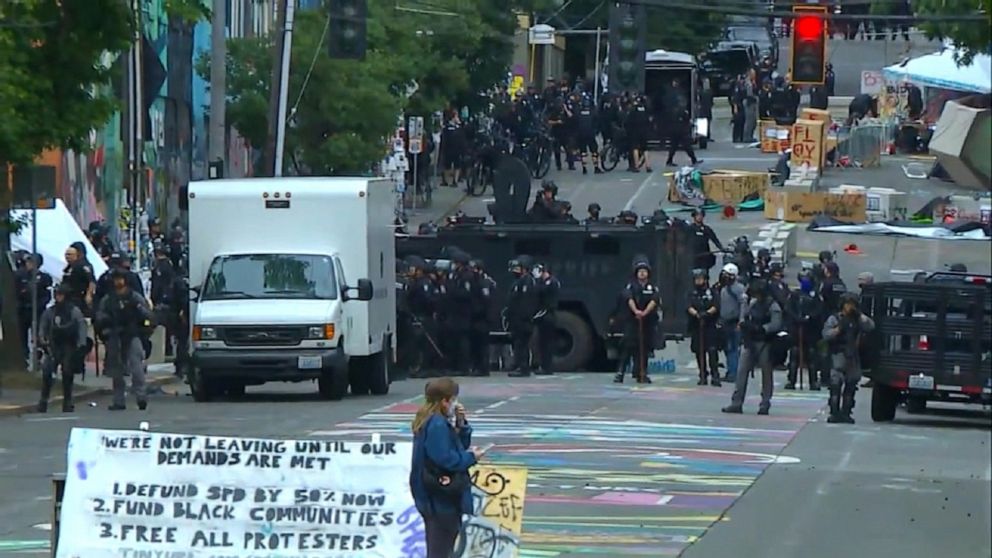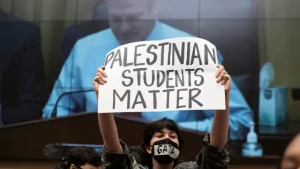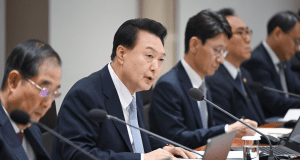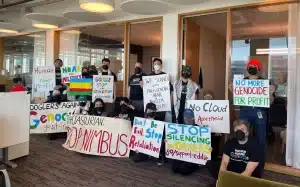The movement for justice for George Floyd has suffered a setback. On Wednesday morning, July 1, Seattle Police, Bellevue Police, and the FBI moved in to clear out the Capitol Hill Organized Protest (CHOP), the five to six-block area around the former East Precinct of the Seattle Police. At least 31 people were arrested during the invasion by over 100 cops. The mayor declared the area off-limits.
In a related matter a day earlier, Mayor Jenny Durkan called for a city council investigation of Kshama Sawant, a socialist councilwoman and Black Lives Matter movement supporter. Durkan made clear that the results of such an investigation could carry the potential of punishing Sawant for her political activities and even expelling her from council.
CHOP was set up on June 8, when the police temporarily abandoned the East Precinct. Before CHOP was set up, there had been street battles outside the East Precinct for several days in a row. Police had set up barricades a block away. The demonstrations were largely peaceful. When there was jostling at the barricades, the cops unleashed chemical weapons on protesters and cleared them out. In spite of the vicious police attacks, Black Lives Matter demonstrators came back day after day and night after night.
The city budget and police were strained by the continual conflict and finally gave in to the protests. The protesters initially set up Capitol Hill Autonomous Zone, representing the goal of some to withdraw from government control. Very soon after this, participants changed the name of the zone to CHOP. This change was made to emphasize that the zone was being used to continue organizing against police brutality and racism.
The establishment of CHOP was a victory for the Black Lives Matter movement. The mayor made the decision to temporarily abandon the East Precinct. The police chief, Carmen Best, publicly opposed the abandonment from the beginning. The creation of CHOP was unique or nearly unique in the U.S. As such, it drew the ire of racists and conservatives all over the U.S. The tweeter in chief denounced CHOP as being run by “ ugly anarchists” and threatened to send in the U.S. military to clear out the zone.
The denunciation of CHOP as lawless and dangerous did not reflect reality. The zone bloomed with creativity. Activists planted an organic garden in nearby Cal Anderson Park. Homeless people set up tents in the park and on the liberated sidewalks. Activists copied Washington, D.C., in painting “Black Lives Matter” in giant letters on the street in CHOP. Barricades were festooned with graffiti. Artwork was everywhere. The No-Cop Coop gave away free items. Free food was provided by many groups. The area was vibrant and peaceful. A General Assembly met every afternoon.
CHOPP was a central organizing space for protests going to other areas of the city. There were regular rallies at the West Precinct in the downtown area. While CHOP continued, protests against police brutality and racism took place all over the city and beyond. On June 12, during the BLM-declared “general strike,” 60,000 people marched from the Central Area to Beacon Hill, while at least four other protests took place throughout the city. On Juneteenth, thousands of people likewise came out all over the city. On June 28, over 1000 people marched on the mayor’s house to demand defunding the police, investing those funds in social programs in the Black community, and dropping charges against all protesters.
Attacks on CHOP increased after killings
The attack by politicians and the media increased after June 20, when a young man was tragically killed near CHOP. From that point on, the barrage of criticism never stopped. Unfortunately, there were three other shootings in or near CHOP over the next 10 days. The origin of these is unclear, but CHOP was blamed for all of them. In one case, a Black man was attacked by racists as he left CHOP late at night. Even this bigoted attack was blamed on CHOP.
Complimenting the media and politician attacks was the distancing of some members and false friends of the movement on CHOP. Early on, pro-police elements infiltrated CHOP, speaking at the assemblies in support of Black police and calling for dialogue. They didn’t get a good reception. However, even community groups that had been opposed to police killings came out against CHOP. They pressed their agenda of police reform rather than the serious defunding of the police that CHOP wanted. They said CHOP had made its point and should disband.
One problem in CHOP that facilitated these attacks was weak central organization. The area was very organized as far as providing services and a center for discussion and movement building. However, it had no recognized democratically elected leadership. This allowed different messages to come out of CHOP. The setting up of CHOP was ad hoc and not part of a clear strategy. At one poin , a week before its demise, one group claiming to represent CHOP put out a tweet that the project was over. Other “leaders” at CHOP vehemently denounced this.
The result of the continual political and media attacks, the shootings blamed on CHOP, and the harping of false friends led to an erosion of active support for CHOP. Even supporters wondered what the point of continuation was. The crowds in the CHOP zone dwindled by the day. At the end, a few dozen were still left camping out in the park or on the sidewalk near the former precinct building.
A couple of attempts were made to reduce or clear CHOP. Finally, on the morning of July 1, the city felt strong enough to move in with 100 cops and clear the area as well as temporarily closing the nearby park.
The end of CHOP is definitely a setback, but it is by no means the end of the movement for George Floyd in Seattle. Demonstrations will continue throughout the city. The pressure to defund the police and drop the charges against the protesters will keep up. The city council is considering the police and general city budget, and this will be a focus. There may also be demonstrations directly against the shutdown of CHOP and demanding release of the CHOP arrestees.
Mayor Durkan attacks socialist councilwoman
There is another related issue: the attack on Socialist Alternative city councilor Kshama Sawant by Mayor Jenny Durkan. Sawant has called for the impeachment of Durkan for her support of police brutality in the recent protests. Durkan, of course, claims to support Black Lives Matter and has given minor concessions to the movement.
Durkan has responded by calling on the city council to investigate Sawant, perhaps leading to her expulsion from the council. She claims Sawant misused her office to facilitate the movement in Seattle. Sawant led a brief occupation of City Hall on June 9 and then led demonstrators back to CHOP (then called CHAZ) to reinforce it. Durkan also said that she has misused her office to support the Tax Amazon movement.
Finally, Durkan is particularly upset that Sawant spoke at a rally of 1000 people in front of Durkan’s mansion on June 28. She claims that Sawant “led” the demonstration, which chanted “ Jenny Resign!” Durkan claims that this demonstration endangered herself and her family. Although Sawant was a speaker at the rally, however, she did not organize it. The rally was organized by the Seattle chapter of Democratic Socialists of America.
Durkan’s attack is an attempt to suppress the right of free speech and organizing. It shows her real position on the Black Lives Matter movement, which contradicts her liberal rhetoric. It shows something else as well: capitalist politicians want all political organizing to play out by the “official” rules that favor the rich. They don’t think it is legitimate for socialists or other movement activists to use their political positions to build grassroots movements. These movements threaten the wealth and power of the ruling class, and corporate politicians want to do everything they can to squelch them. Of all the members of the city council, even the ones who claim to be progressive, only Sawant actively builds movements.
In response to Durkan’s action, Sawant pointed out, “Durkan’s attack on my office is an attack on the grassroots campaigns we’ve participated in and helped lead alongside many others, and the progressive victories we have all won together. … In reality, this is an attack on working people’s movements, and everything we are fighting for, by a corporate politician desperately looking to distract from her failures of leadership and politically bankrupt administration. Our movement will respond accordingly: we will fight with even greater unity and determination.”
The movement in Seattle and nationwide needs to strongly support Sawant in her defense against Durkan!
This articles was originally published in https://socialistresurgence.org/










